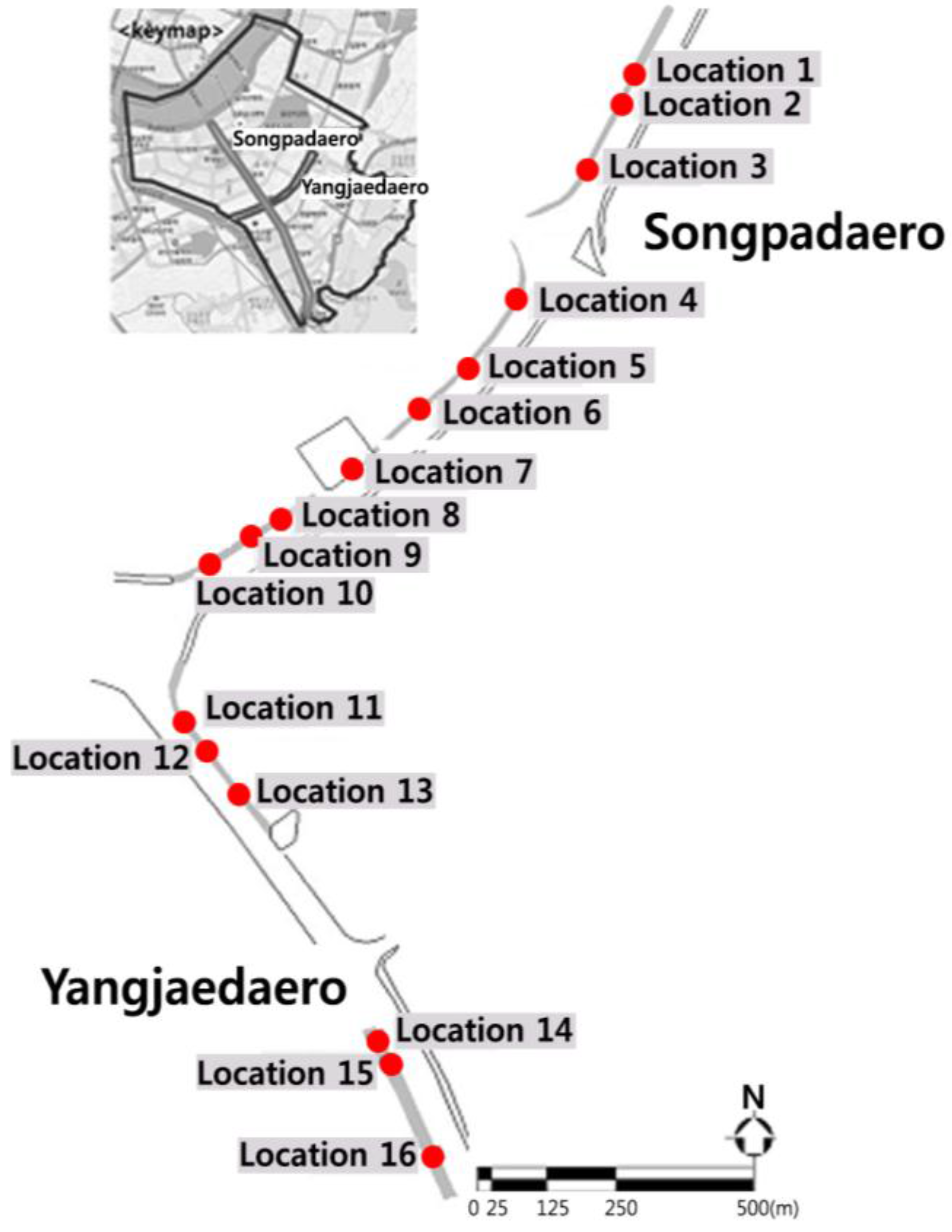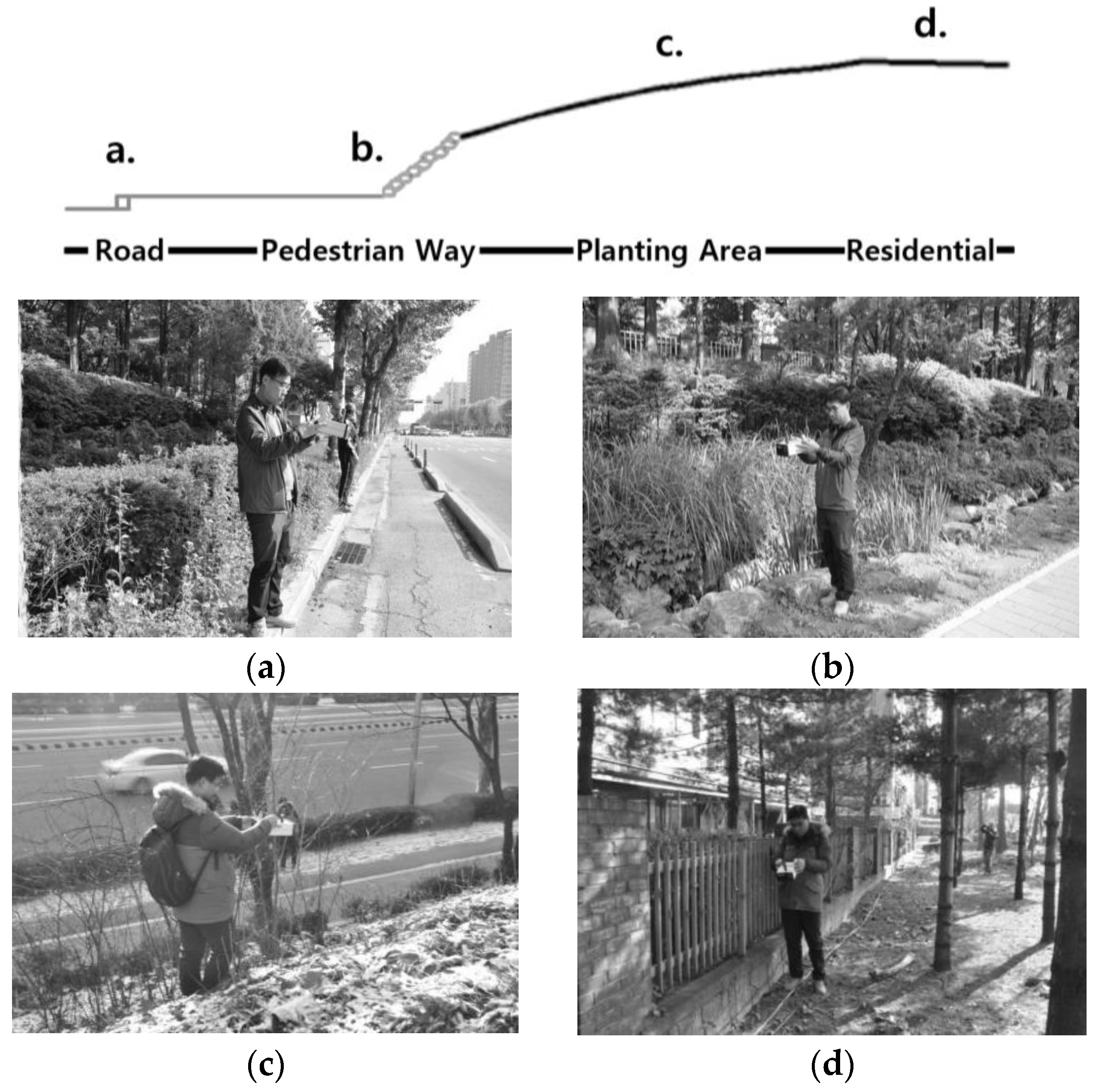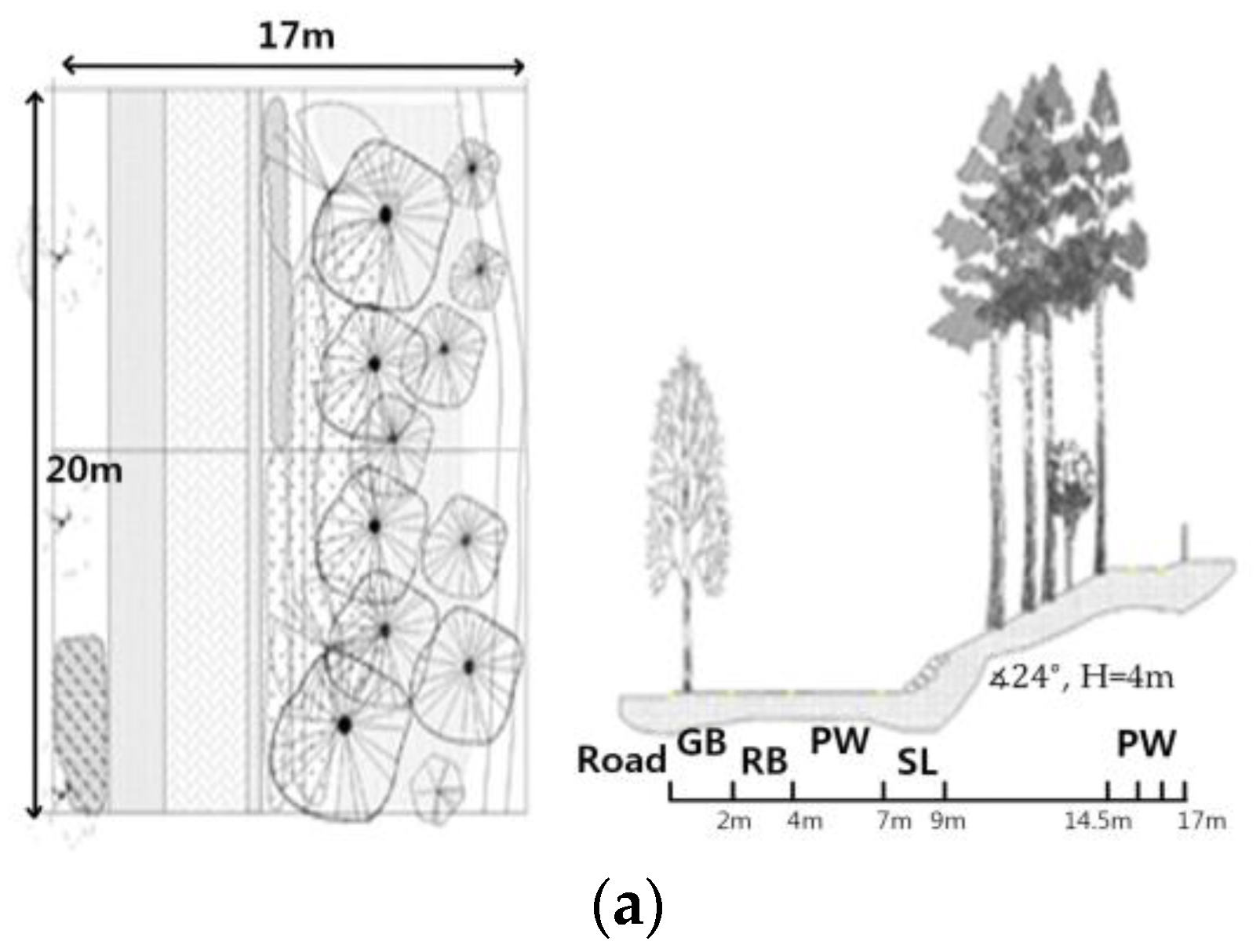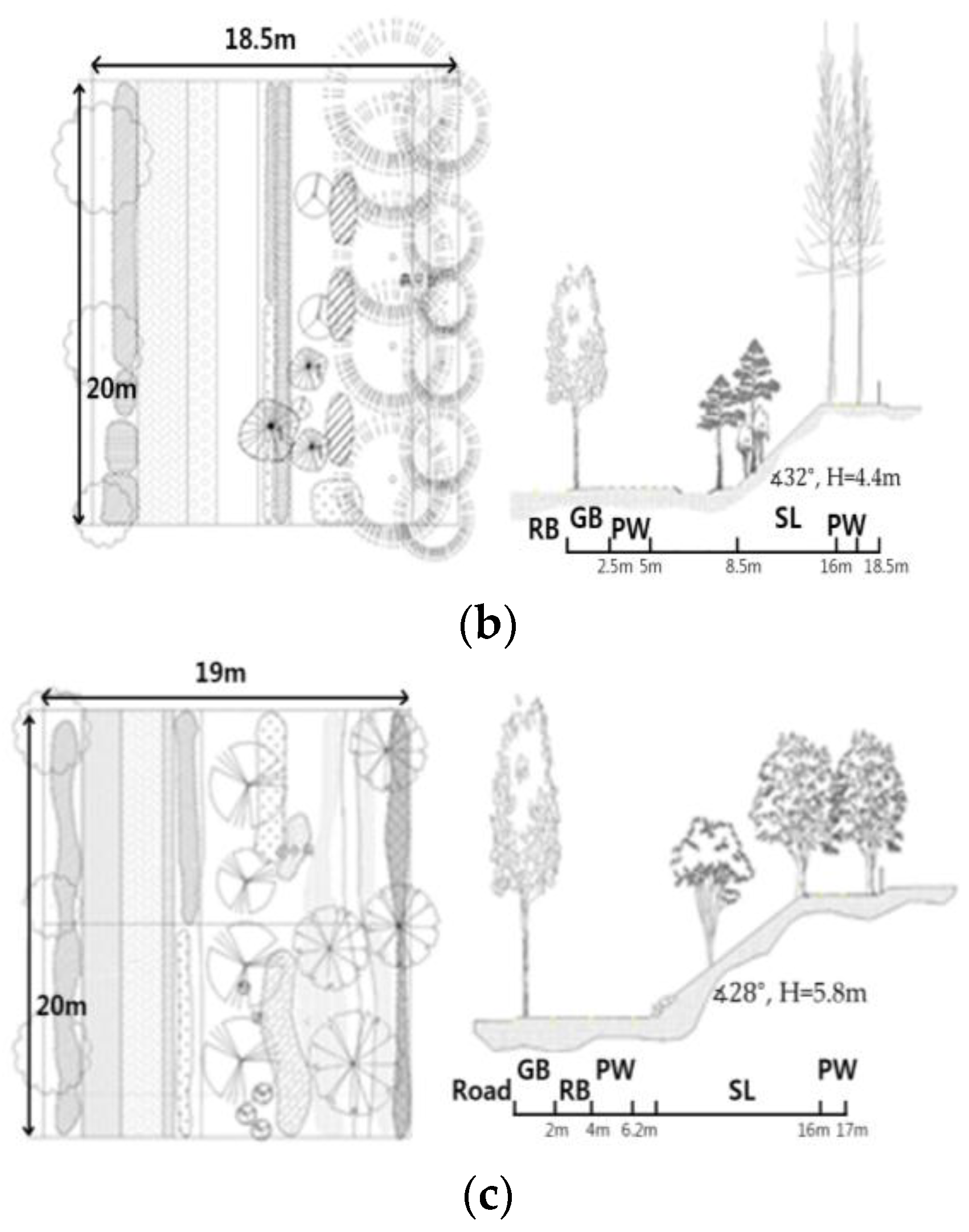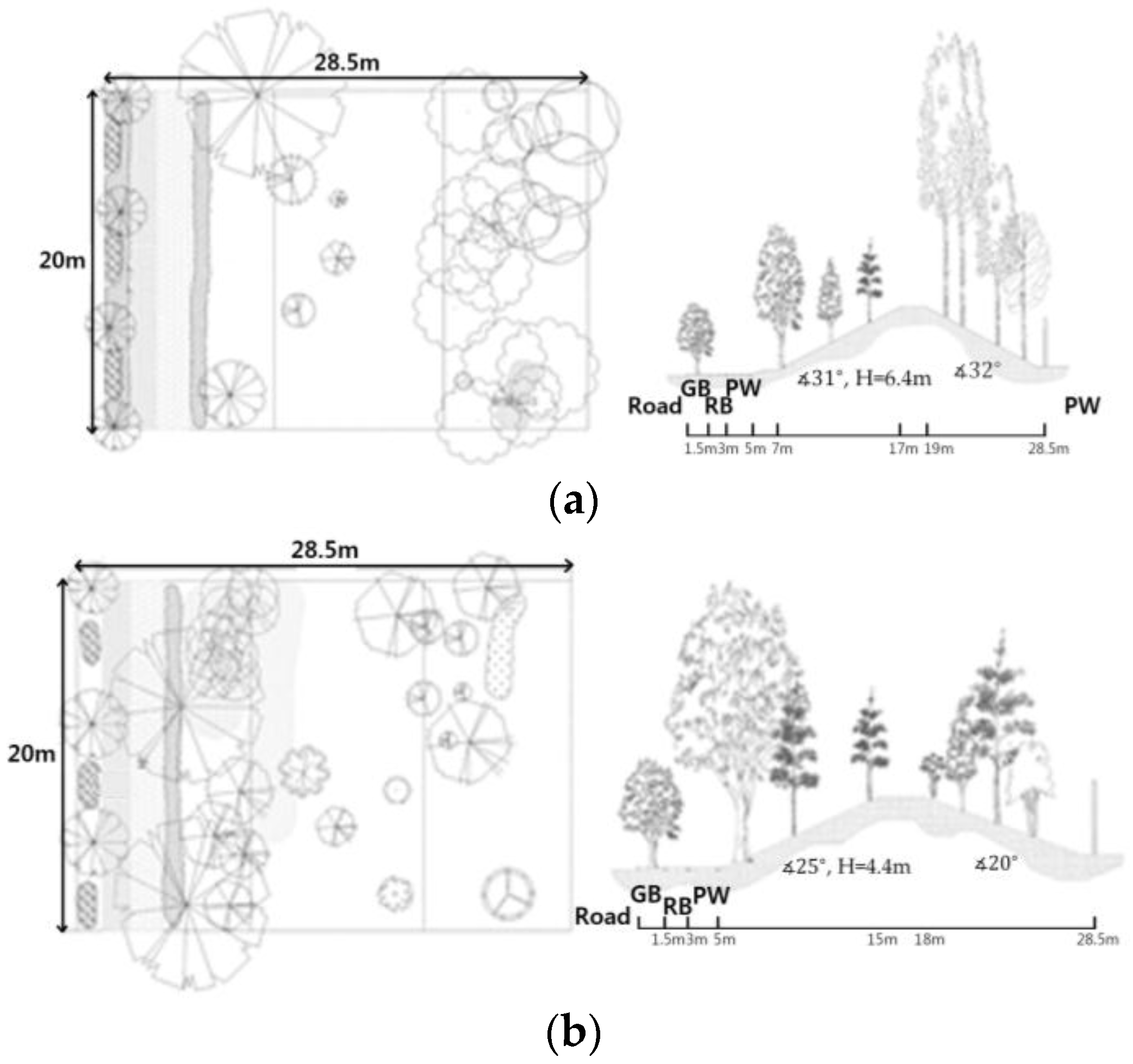1. Introduction
The definition of fine particles is the particles with diameter more than 2.5 micrometre (µm) and less than 10 µm, also known as particulate matters (PMs). Especially, PM
2.5 particulate classes and are considered to have several more critical health implications than those classes of larger particulates [
1,
2]. According to the World Health Organisation (WHO), fine particles is a cancer causing material Grade 1 [
3]. Due to a sequence of industrialization and rapid urban growth, within air pollution, PM
2.5 is one of the major urban environmental and health problems in many Asian cities. The majority of research and health policies have focused on PM
10 in Seoul, South Korea so far; however, a few recent studies [
4,
5] have started to examine both PM
10 and PM
2.5 [
2]. Often, Seoul suffers a dusty spring affected by the Asian Dust Storm from the desert areas of China and Mongolia [
6].
Seoul is located in a basin surrounded by mountains to the north, east, and south, whereas it opens to the west on adjoining the city of Incheon and further to China across the sea, where many different elemental sources can be found [
7]. The climate of Seoul is characterised by a cold, dry winter and a hot, humid summer influenced by the summer monsoon from the ocean. PM in ambient air is one of the major public health concerns in metropolitan cities such as Seoul [
7,
8], and recent epidemiological studies have reported close association between PM levels and increased hospital admissions attributable to respiratory and cardiovascular diseases [
9,
10,
11]. In South Korea, PM
10 regulations have been publicized since 1996, which are 70 µg/m
3 for an annual average and 150 µg/m
3 for a 24-h average. There has been a number of attempts to reduce the air concentration levels of not only PM
10 but also PM
2.5 [
5,
12,
13,
14].
Although such health risk of fine particles is found within the science and environmental interaction literature, it has been neglected in the context of urban green space such as street trees [
4,
11,
14,
15]. Moreover, the methods using tree planting patterns to resist air concentration levels of PM
2.5 has been largely unexplored. Viewed through this lens, previous fine particle literature and the findings from experiences as landscape practitioner are uniquely drawn together within this paper to explore the potential of street tree planting to minimize the concentration level of PM
2.5.
The paper aims to explore the effects of planting buffers as the reduction methods of fine particles (PM
2.5) in urban areas. Moreover, it analyses the changes of fine particle concentration levels by planting structures, green volumes and planting types of roadside green buffers. A case study was employed as a research methodology: 16 survey locations on three main streets in Seoul were chosen, which indicated the greatest PM
2.5 emission per year based on Seoul statistics [
16].
2. Real Threats of Fine Particles (PM2.5)
Particulate matters (PM) are microscopic solid or liquid matter suspended in the Earth’s atmosphere [
12]. PMs could be natural or man-made and the impacts on environment and precipitation harmfully affect people’s health [
17].
The International Agency for Research on Cancer (IARC) and WHO define airborne particulates a Group 1 carcinogen [
18]. Particulates are the lethal figure of air pollution due to their penetration deep into the lungs and blood stream, triggering permanent DNA disorders, heart attacks, and premature death. According to research carried out in 2013 [
19,
20], there is no safe level of particulates, and, for every increase of 10 µg/m
3 in PM
10, lung cancer increased 22%. In particular, PM
2.5 were fatal, with a 36% rise in lung cancer per 10 µg/m
3, since it tends to penetrate deeper into the lungs. Particulate matter in the air causes visual effects, such as smog composed of sulphur dioxide, nitrogen oxides, carbon monoxide, mineral dust, organic matter, and elemental carbon, also identified as black carbon [
21,
22,
23]. The particles also cause poor visibility and yellow colour [
18,
21].
In general, smaller and lighter particles can stay in the air longer: particles larger than 10 µm diameter could settle down on the ground in hours, whereas particles smaller than 1 µm diameter could be in the air for weeks. In fact, most particulate matter comes from diesel engine emissions [
1,
24]. A complex mixture of solid and liquid particles could form particulate matter and these particulate matter emissions are substantially regulated in most developed countries. Because of such environmental concerns, most industries are required to work with counter measures to control particulate emissions [
15].
Since atmospheric aerosols affect the earth climate by altering the total sum of receiving solar radiation and outbound terrestrial long wave radiation held in the earth, there are direct, indirect and semi-direct aerosol effects through some distinct mechanisms [
20,
24]. The aerosol climate effects are the major cause of ambiguity in future climate changes. The particle size is a decisive factor of the respiratory expanse. While larger particles are normally sieved in the nose and throat, those smaller than 10 µm, could cause health problems by staying in the bronchi and lungs. Even though PM
10 does not signify a strict borderline between respirable and non-respirable particles, internationally, most statutory bodies monitor the airborne particulate matters since PM
10 is capable to infiltrate the lungs deeply.
Similarly, PM
2.5 is able to infiltrate into the gas exchange parts of the lung, so-called alveolus; whereas, less than 100 µm diameter particles could affect other organs as well. The effects of breathing particulate matter have been extensively studied in humans and animals [
19,
25]. A study carried out in 2002 [
23] illustrated that PM
2.5 cause serious health problems such as heart attacks and other cardiovascular problems. The European Study of Cohorts for Air Pollution Effects (ESCAPE) carried out a study for the duration of 11.5 years, with 100,166 participants. It found that an increasing approximate yearly contact to PM
2.5 of 5 µg/m
3 was related with a 13% increased risk of heart attacks [
25]. Moreover, according to WHO [
21], fine particle air pollution could cause approximately 3% mortality rate from various heart diseases, approximately 5% death rate from different cancer, and approximately 1% death rate from severe respiratory infections in children under five years old internationally. In addition, even though there is a short period contact in high concentration levels, fine particles could critically bring heart disease [
22]. A study carried out in 2011 indicated that car emission is the single most critical cause of heart attack in the general public, accounting for 7.4% of all causes [
26,
27]. For this reason, high concentration levels of particulate matter in the air could cause plant growth or mortality problems.
Because of such a health threat from particulate matter, most governments have placed statutory guidelines both for the emissions allowed from certain types of pollution sources (motor vehicles, industrial emissions, etc.) and for the ambient concentration of particulates [
18,
19,
28].
Table 1 shows fine particle air pollution is regulated, internationally; however, PM
10 is generally focused on, while PM
2.5 needs to be incorporated accordingly.
However, such regulations have not been supported by effective implementation plans yet, since there are too many ways to approach such as legislations in car emission, manufacturing sector, and building industries. In particular, the methods for reducing fine particle air pollution by implementing urban open space has been relatively unexplored. Some research was carried out in accordance with urban open space. For instance, an analysis of the effect on airflow and temperature of planting schemes was investigated [
30,
31,
32]. The results were drawn by an experiment that measured temperature and airflow on various green facades, and robust contribution of vegetation to the thermal behaviour of the building was found. Moreover, the removal of air pollution by urban planting areas were investigated (e.g., in the United States [
33]). Based on hourly meteorological monitoring within a heavily air polluted area, the research found that the management of urban tree canopy cover could be a feasible approach to improve air quality. Similarly, air pollution levels were tested in conjunction with the leaves tissue and foliage dust in Vienna [
34]. The research found that the elemental concentrations of leaves were drastically higher in urban area for manganese and strontium and the urbanisation influenced considerably the elemental concentrations of foliage dust and leaves. Considered as a green lung in urban environment [
10,
35], planning areas have great potential to play a role in reducing fine particle air pollution.
3. Research Methodology
The study aims to verify the effect of planting buffers, built as urban planning facilities, on the reduction of fine particles (PM2.5) and analyse changes in fine particles by the structure, green volume and planting types of street side planting buffers, thus drawing factors that can be used when planting buffers are built to reduce fine particles based on the results.
Whilst the lead author has worked on many planting schemes involving urban areas, the research for this paper began with a case study of Songpa area in Seoul investigating about planting pattern, structure, and green coverage rates of urban trees. Statistically, Songpa area has the most car emissions recorded, which is the main cause of fine particles [
36]. Within the area, major roads and residential areas were selected. Sixteen survey locations on three main streets within the area were chosen, which showed the highest emissions of PM
2.5 per year and per unit area. Five planting buffers adjacent to two of Songpa-gu’s main roads, “Yangjaedaero” and “Songpadaero” (
Figure 1), were built.
As an investigation into the current situation of planting buffers, this study examined cross sectional width, height, and ground conditions of each planting buffer, and investigated types and structures of planting buffers. In fact,
Table 2 illustrates the survey category and how this paper classified open space. The gradient was calculated using the topographical map of Songpa-gu provided by Korea National Spatial Data Infrastructure Portal and using AutoCAD 2012. As a result, actual size of planting band and area for each location is shown in
Table 3.
Moreover, the study also surveyed the species, diameter at breast height (DBH) growth, height, clear-length and crown width of trees and shrubs, and their populations and locations, and made a plan view and a sectional view based on the results.
According to the automatic weather stations (AWS) data of Seoul, and based on previous studies, more fine particles (PM2.5) are generated in spring and winter. Thus, this study measured the concentration of PM2.5 for office-going hours with heavy traffic during the weekdays, twice, in January and May. Particularly, each investigation site was divided into four types: roads, sidewalks, green spaces and residential areas. This measurement was conducted eight times for each spot.
The fine particles (PM2.5) level is higher in winter than spring period. Whereas, the concentration levels decrease in the order of planting, pedestrian, and residential areas in winter, the concentration levels decrease in the order of pedestrian, planting, and residential areas in spring. There was clear variation of PM2.5 concentration levels seasonally due to the leaves in vegetation. In terms of ground condition, because of the three-dimensional volumes of tree and shrubs, the sloped planting areas had better performance than flat areas in reducing PM2.5 levels in spring time, whereas the flat area of vegetation had less PM2.5 levels in winter time.
First, site survey of road and facilities were carried out to analyse green structure. For individual trees, species, heights, and widths (root, breast, and overall) were surveyed. Then, based on the surveyed information, plans and sections were drawn. Data were collected on 14th January for winter and 12th May for spring based on research [
37,
38] claiming that fine particles were dense on winter and spring. The surveyed locations were classified as road, pedestrian, planted, or residential areas, and the fine particle concentrations of all 16 locations were checked eight times each. To find relationships between density and effects, planting areas were divided into three types: flat, slope, and mounding. Planting structures were classified as 1, 2, or 3 rows of trees and for shrubs, vertically classified as singular, double, or multiple shrubs, respectively. Green coverage rates were also surveyed in each location.
The site, Songpa area, also has higher number of registered cars in Seoul. This study attempted to find how PM2.5 concentration level varies on different vegetation volumes; therefore, within Songpa district, five locations of Green Buffer Zone (GBZ), which indicates three-dimensional volumes of vegetation for certain square meter area, have been selected. All sites were planted in 1986, and placed near residential apartment blocks. Each location has 3–4 PM2.5 survey spots. As for current situation of each investigation site, this study divided all the green spaces into three different types based on ground conditions and analysed the mean green volume. As a result, the undulated mounding type planting areas have the highest mean green volume of 5.35 m3/m2, the tree green volume coefficient, and 0.48 m3/m2 in the shrub green volume coefficient, but, as the tree green volume coefficient of the slope-type green space was 2.95 m3/m2, and the shrub green volume coefficient of the plain-type green space was 0.11 m3/m2, the slope type had more tree green volume than the plain type, while the plain type had more shrub green volume than the slope type. As for the planting structure, this study divided the structure of trees into three types of tree, row-single row, two rows, and three rows, and the structure of shrubs into three types of layer-single layer, double layer and multi-layer to arrange the actual states of green spaces in each investigation site.
To quantity plant coverage and volume, Planting Density (PD), Plant Coverage (PC), and GVZ (Grüvolumenzahl) were calculated. This study attempted to find out how PM
2.5 concentration level varies on different vegetation volumes. PD indicates number of plants in a certain area. For trees, actual count was used, whereas, for shrubs, the survey assumed 16 numbers per square meter.
PC also illustrates two-dimensional (plan view) coverage rates; however, overlapped areas have not been considered in this study. Firs, two-dimensional projection (plan) can be calculated:
Then, Plant Coverage (PC) can be calculated with PVPA.
The plant volume was calculated by using the plant volume calculation formula (
Table 4). GVZ indicates three-dimensional volumes of vegetation for certain square meter area. GVZ (Grüvolumenzahl) can vary depending on the shape of tree such as sphere, conical, and columnar. It is also divided by trees and shrubs and the formula has been provided [
39].
In Seoul, a sharp temperature change occurs in the period between December and March when average temperature is below 10 °C. The wind speed during 2014 and 2015 is from 1.0 to 2.0 m/s, which is relatively steady. Overall, PM2.5 concentration level in Seoul was obtained from Automated Weather Station (AWS) since 2014 and Songpa District exceeded average level of Seoul, 25 µg/m3 between January and May 2014. According to AWS’s data, PM2.5 levels are relatively lower in summer than spring and winter. In detail, S and K levels are higher in spring, decreasing in the order of winter, autumn, and summer. Conversely, Zn level is higher in winter, decreasing in the order of spring, summer, and autumn. Furthermore, Pb level is also higher in winter, decreasing in the order of autumn, spring, and summer. Finally, Al, Fe, and Ca levels are higher in spring, decreasing in the order of winter, autumn, and summer. These environmental variables are including energy consumption in winter, monsoons in summer, wind levels, etc.
In the site survey, together with the AWS data, the Real-time Automated Measurement (RAM) method has been employed to measure the PM
2.5 concentration level. RAM method, also called β ray Absorption Method, can test the concentration levels of fine particles using β ray, fine, and vibration. In terms of choosing direct reading devices of fine particles, the study selected Air-Aide Model AA-3500 Airborne Particulate monitor supplied by Environmental Devices Corporation, which can measure and display the results immediately on site (
Table 5). Every linear planting strip, cross-sectionally four spots of roadside, pedestrian way, planting area, and residential side—approximately 20 m—were tested with the device at approximately chest height (120 cm) for 4 s and repeated eight times (
Figure 2).
The study also employed SPSS 21.0 to find the relationship between three-dimensional volumes and planting structures. One-way ANOVA was carried out with tree structures classified in single, double, and triple rows, and shrub structures divided into single, double, and multiple layers vertically. In particular, one-way ANOVA was employed to find seasonal differences of PM2.5 and planting structures.
4. Results
The collected quantitative data could be divided into three areas, sloped, flat, and mounded, as per ground conditions of the planting areas. First, the three survey locations were identified as flat ground planting areas, as shown in
Figure 3. The three survey locations also have three different planting types of single, double, and triple row of trees.
Figure 4 and
Figure 5 illustrate the sloped ground areas and the mounded ground areas.
Location 12 has the highest tree density, which led to highest PVPA and GVZ for trees, whereas Location 13 has the highest density, PVPA, and GVZ for shrub. Generally, higher shrub density sites showed lesser tree density, and, therefore, there is more space available for shrub planting as similar results could be found in the sloped ground condition sites. Single tree row planting site, Location 11, has the smallest GVZ quantity, whereas Location 12, where triple rows of tree planting exists, has the highest number of tree density, PVPA, and GVZ. For sloped ground areas, PVPA and GVZ showed quite similar results to each other, whereas PD values of trees and shrubs indicates opposite relationships, since it is found that more shrubs—or multiple layers of shrubs—is linked to higher PD values. The results of the mounded ground areas did not show much difference with flat and sloped ground conditions (
Table 6).
The winter survey was carried out on 14th January 2016 and it started at 07:30 a.m. when car traffic is peak due to prime commuting time. The day of the survey had temperatures of −8 to −1 °C, 24–49% humidity level, and wind speed of 1–2 m per second during the survey time. The winter survey indicates that the average concentration level of PM
2.5 was 55.5 µg/m
3, the lowest was 17.0 µg/m
3 and the highest was 114 µg/m
3. On the other hand, the spring survey was carried out on 12 May 2016 and it started at 08:00 a.m. The day of the survey had temperatures of 2–22 °C, 45–60% humidity level, and wind speed of 1–4 m per second during the survey time. The spring survey indicates that the average concentration level of PM
2.5 was 38.6 µg/m
3, the lowest was 18 µg/m
3 (residential area) and the highest was 84 µg/m
3 (roads) (
Table 7).
Based on the winter and spring surveys, some comparisons can be made (
Figure 6). Location 14 showed the lowest concentration levels in both spring and winter, whereas the highest concentration levels varies in seasons and locations. There are many seasonal changes at Locations 8 and 9. At Locations 4, 13, and 16, the concentration levels of spring survey were higher than that of winter survey; therefore, PD, PVPA, GVZ, seasonal and locational analyses are required. Average concentration levels of spring was 38.6 µg/m
3, which is lower than that of winter (55.5 µg/m
3). Previous research also claimed [
38] that winter generally has lower value than the rest of the year.
In terms of differences per locations, such as roadside, pedestrian way, planting area, and residential area, the study results are illustrated in
Table 8.
The average PM2.5 concentration levels in the winter decreased in the order of roadside, planting area, pedestrian way, and residential area, which, interestingly, indicates the planting area has higher concentration than the pedestrian way. In the spring, however, it decreases in the order of roadside, pedestrian way, planting area, and residential area. This is due to deciduous trees when the leaves are back in the spring. The filtering effects of deciduous trees in the spring provided much lower PM2.5 concentration levels than in the winter.
5. Discussion
As a result of measuring the concentration of PM2.5, this study found that it was 55.5 µg/m3 on average in winter, which was a harmful level according to the integrated environmental index provided by Seoul City, saying that levels above 50 µg/m3 may have harmful effect on sensitive groups of people. Particularly, the concentration of PM2.5 was 38.6 µg/m3 on average in spring, which exceeded the mean concentration of PM2.5 in Seoul City in 2015. The mean concentrations of PM2.5 in every investigation spot were 46.6 µg/m3 for sidewalks, 45.5 µg/m3 for green spaces and 42.9 µg/m3 for residential areas, all of which were lower than 53.2 µg/m3 for roads, regardless of the season, and, especially, the concentration of PM2.5 for residential areas was lowest. As seasonal characteristics, the concentration of PM2.5 for green spaces (55.5 µg/m3) was higher than that for sidewalks (54.2 µg/m3) in winter, but, in spring, that for green spaces (35.9 µg/m3) became lower than that for sidewalks (39.0 µg/m3). As for the fluctuated concentration rate of fine particles in every investigation spot, the slope type showed an increase by 93.9% in winter, which was higher than the increased rate of the plain type (88.5%), and, in spring, the slope type showed a decrease by 69.5%, which was lower than the decreased rate of the plain type (75.1%).
Accordingly, this study confirmed that the slope ground type having the greatest tree green volume was more effective on reducing fine particles in spring, while the flat ground type having the most shrub green volume was more effective in winter, which indicates that the green volume of green buffers has great effect on the reduction of fine particles.
In the stage of confirming the effect of green buffers, this study analysed the correlation between the green volume of vegetation and the fluctuated rate of fine particles. As a result, it was found that the green coverage rate of trees and shrubs was related with the crown volume in every investigation spot, but they were mutually and complexly affected by each other.
As a result of analysing correlations between fluctuated concentration rate and the tree structure, this study found out that single row of trees showed the highest fluctuated concentration rate of PM
2.5 (84.77%), followed by double rows of trees (79.49%), and triple rows of trees (75.02%), indicating a negative correlation: the fluctuated concentration rate of PM
2.5 becomes lower with more rows of trees (
Table 9).
Besides, as a result of analysing the effect of shrub structure, it was found that the single layer showed 88.79% in the fluctuated concentration rate, while the double layer and the multi-layer showed 81.16% and 68.93%, respectively. Therefore, this study concluded that more layers of shrubs are more effective at reducing the concentration of PM
2.5 (
Table 10).
As for seasonal characteristics, this study analysed the correlation between the concentration of PM
2.5 for residential areas in winter and the green coverage rate of each green space type. As a result, this study found out that there was a negative correlation, showing that the higher the shrub green coverage rate is, the lower the concentration value becomes in all ground types—slope, flat, and mounded. Moreover, based on the ground types of residential area, a one-way ANOVA has been carried out in the winter as shown in
Table 11,
Table 12 and
Table 13.
All the factors affecting the reduction of fine particles were related to the green space coefficient (m
3/m
2) through the green coverage rate (%) as a meaning of area and the green volume (m
3) as a meaning of bulk, and they were also affected by the complex structure of trees and shrubs. Thus, this study confirmed that the number of tree rows and the number of shrub layers have negative correlations with the fluctuated concentration rate of PM
2.5. Especially, it was judged that the shrub green volume has greater effect than any other factor, and each green space type shows a negative correlation with the shrub coverage rate in winter (
Table 12 and
Table 13).
Overall, the paper investigated the concentration levels of PM2.5 in roadsides, planting areas, and residential zones and attempted to identify any significant factors influencing the lessening of PM2.5. After the survey in winter and spring, it was found that there was serious PM2.5 concentration levels in the areas of pedestrian paths, planting, and residential areas compared to other urban areas, especially, a substantially lower level of PM2.5 concentrations were revealed in the residential areas located behind planting bands as green buffer.
The concentration levels of PM2.5 are generally surveyed to be higher in winter than spring. However, the concentration levels of PM2.5 decreases in the order of planting areas, pedestrian ways, and residential areas in winter, whereas, it decreases in the order of pedestrian ways, planting areas, and residential areas in spring. There was clear variation of PM2.5 concentration levels seasonally due to the leaves in vegetation. In terms of ground condition, because of the three-dimensional volumes of tree and shrubs, the sloped planting areas had better performance than flat areas at reducing PM2.5 levels in spring, whereas, the flat area of vegetation had lower PM2.5 levels in winter.
Quantitatively speaking, planting coverage rate and three-dimensional volume is critical to influence the concentration level of PM2.5; however, qualitative factors are planting types and structures. In particular, the existence of shrub planting bands was a key factor to reduce the density of PM2.5, which led to concluding that creating multi-layered shrub planting is the most effective way of reducing PM2.5 levels. In some tree planting cases, too many overlapping planning centres between trees can cause blocking PM2.5 diffusions into the air, which increases the concentration level of PM2.5. Therefore, leaving sufficient gaps among trees is recommended.
6. Conclusions
Thus far, a number of studies has been carried out to resolved the health risk hazards of PM2.5; however, the methods using urban trees planting schemes are relatively unexplored in South Korea, despite urban trees being considered green lungs within larger cities. Therefore, this study aimed to explore the effects of planting buffers as the reduction methods of fine particles (PM2.5) in urban areas. Moreover, it analysed the changes of fine particle concentration levels by planting structures, green volumes and planting types of roadside green buffers. A case study was employed as a research methodology, where 16 survey locations on three main streets in Seoul that indicated the highest PM2.5 emissions per year based on Seoul statistics were chosen.
The findings are summarized in the previous section; however, notably, the quantitative factors affecting on the concentration level of PM2.5 were planting coverage rate and three-dimensional volume of plants, whereas, planting types (including ground conditions) and structures are highly influential qualitatively. The most effective urban planting structures for reducing the concentration level of PM2.5 were triple rows of tree planting and multiple layers of shrub structure. Similarly, the plant coverages of shrubs and PM2.5 concentration level have a negative correlation in all ground conditions. Moreover, shrub plantings play critical role in reducing the density of PM2.5. It is also found that dense tree planting did not guarantee the reduction of PM2.5 since more gap among trees allow the diffusion PM2.5 in the air, thus sufficient gap is required for trees to reduce fine particles in larger cities.
However, this study could not include all environmental variables within urban areas; moreover, the surveys were only carried out in two seasons, spring and winter, when critical changes occur due to leaves in plants. Further research needs to be carried out to investigate some important factors, such as efficiency comparison between evergreen and deciduous, screening planting distance from PM2.5 sources, and planting species variations in the future.
Currently, relevant legislations only deal with planting width and plan coverage rate in South Korea, which is not enough to reduce the threats from PM2.5 systematically at the national level. This study found the critical factors of urban planting for reduction of PM2.5 are three-dimensional volumes and quantity of planting bands (rows). In particular, trees need to be planted at certain distance to not trap any PM2.5 and for free movement of winds, and more shrub planting is required to increase three-dimensional volume of urban plantings.
